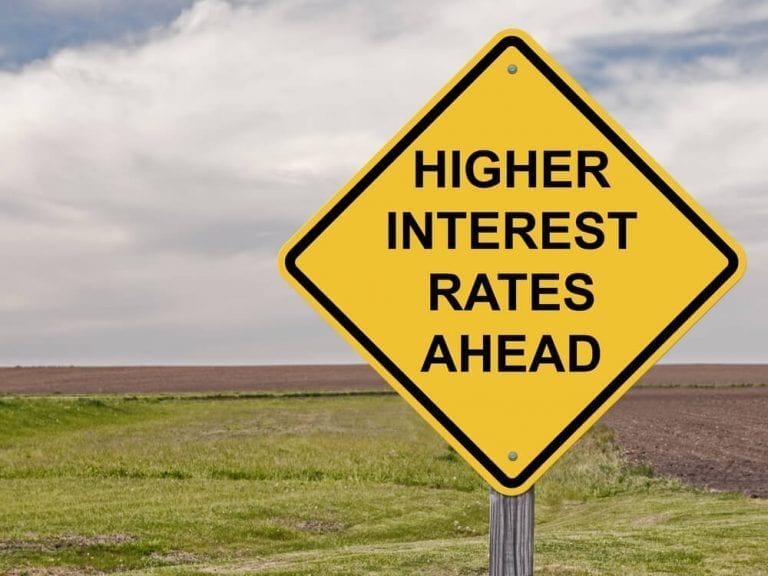American consumers owe a record $1.023-trillion in revolving credit – mostly through credit-card debt – and with interest rates expected to rise in 2018, financial experts predict the problem will escalate unless consumers take a more aggressive approach in paying down their debt.
Revolving credit is growing at an annual rate of 4.9%, a reflection of more consumers getting access to credit cards that are backed by major banks and issuers. The U.S. Federal Reserve said that American credit-card use went from 103.5-billion transactions worth $5.65-trillion in 2015 to 111.1-billion transactions worth $5.97-trillion in 2016.
The continued acceleration of those figures, coupled with higher interest rates, has American consumers swimming in debt not seen since the Great Recession. The New York Federal Reserve said the U.S. collective household debt balances totaled $12.73-trillion in 2017, surpassing the 2008 peak of $12.68-trillion.
“The high levels of debt in this country are very concerning,” said Mark Beyer, a Tampa-based certified financial planner for Edward Jones. “The scary part, according to various reports, is that we are already at or approaching all-time highs in not only credit-card debt, but also mortgage, automobile and student-loan debt. Unfortunately, it would seem the American consumer has not learned their lesson from the Great Recession of 2008.”
Beyer said to expect higher interest rates in 2018 for credit-card users.
“Borrowing rates are typically tied to the prime rate, which is affected whenever the Fed decides to raise the federal funds rate,” Beyer said. “We had three rate hikes (of 0.25%) in 2017 and the Fed has already said they are forecasting a similar approach in 2018.
“With interest rates rising for the foreseeable future, everyone with credit card debt should be making a concerted effort to either pay off or at least pay down their debt to avoid digging themselves into an even deeper hole.”
How would a rise in the interest rates affect credit-card users? Here are some examples:
In early 2018, the Average Percentage Rate (APR) for credit cards was 16.35%, an all-time high. If the Fed has three rate hikes of 0.25% this year, that likely would push the average credit-card APR to 17.10%.
Here’s how that interest-rate increase would affect monthly interest for consumers with $10,000 or $15,000 in credit-card debt.
| Debt | APR Rate | Monthly Interest |
|---|---|---|
| $10,000 | 16.35% | $136.25 |
| $10,000 | 17.10% | $142.50 |
| Debt | APR Rate | Monthly Interest |
| $15,000 | 16.35% | $204.38 |
| $15,000 | 17.10% | $213.75 |
Here’s how an interest-rate increase would affect monthly interest for consumers with bad credit (credit scores at 600 or below), where credit-card APR could conservatively hit 25% or greater.
| Debt | APR Rate | Monthly Interest |
|---|---|---|
| $10,000 | 25% | $208.33 |
| $10,000 | 25.75% | $214.58 |
| Debt | APR Rate | Monthly Interest |
| $15,000 | 25% | $312.50 |
| $15,000 | 25.75% | $321.88 |
The monthly interest variance ranges between $6 and $10, which might seem inconsequential. But in the big picture — especially for consumers stuck in the pattern of making a minimum credit-card payment each month — it can be quite costly. If they are unable to pay down the debt, there’s no quick escape.
Using an example of a 4% monthly minimum payment, here’s how costly and time-consuming these debts can become.
| Debt | APR Rate | Monthly Payment | Payoff Period | Total Payment | Total Interest Paid |
|---|---|---|---|---|---|
| $10,000 | 16.35% | $400 | 153 months (12yrs,9mths) | $15,058.72 | $5,058.72 |
| $10,000 | 17.10% | $400 | 156 months (13 yrs) | $15,418.38 | $5,418.72 |
| Debt | APR Rate | Monthly Payment | Payoff Period | Total Payment | Total Interest Paid |
| $15,000 | 16.35% | $600 | 168 months (14 yrs) | $15,058.72 | $5,058.72 |
| $15,000 | 17.10% | $600 | 172 months (14yrs,4mths) | $23,185.37 | $8,185.37 |
The minimum payment will decrease each month as the balance deflates. Keep in mind, though, the figures would spike higher if there were additional charges, late-payment fees, interest-rate increases or other assorted costs.
Every little bit helps. The simple act of adding $20 or $30 to the monthly minimum payment could cut out years of payments (and thousands of dollars in interest charges).
The best strategy is to avoid deep credit-card debt. American consumers are doing better according to the Financial Industry Regulatory Authority (FINRA), which stated in its 2015 financial capability report that 52% of Americans who used credit cards paid their balance in full each month (up from 41% in 2009). Additionally, FINRA said people who made only minimum payments dropped from 40% to 32% in that six-year period.
But nearly 40% still engage in “expensive’’ credit-card behaviors, such as making only the minimum payment, paying late fees, paying over-the-limit fees or using the card for cash advances.
“I don’t know that the number (32% paying only the minimum) will ever go down (further),’’ said Ric Edelman, the chairman and CEO of Edelman Financial Services, an author of eight books and the host of a weekly syndicated talk radio program on personal finance.
Edelman has a go-to story on the subject. While counseling a couple about their monthly spending, he learned they had $50,000 in credit-card debt. The wife told Edelman they were “fine’’ because they were able to make the minimum payments every month.
“That’s the mindset we’re fighting,’’ Edelman said. “It’s frustrating.’’
Beyer said he tells clients to always check their credit-card statements for minimum-payment details, which must be stipulated as part of the 2009 Credit Card Act. The disclosure includes how much more it will cost and how long it will take to pay off the debt by making only the minimum payment each month.
“It usually comes as an awful surprise,’’ Beyer said.
Chris Garrido, a Tampa-based certified financial planner with the Westshore Financial Group, said he often wonders whether such warnings have a tangible impact.
“For most consumers, their way of life is based on a mentality of, ‘I want it and I want it now,’ ‘’ Garrido said. “They have made ‘lifestyle’ the No. 1 priority in their cash-flow management. That way of life will always lead to over-consumerism. Someone could drive a Chevrolet with a lower payment to leave more money to reduce their other debts, but instead they buy a Lexus with a higher payment to compound their debt problem.
“Since the crash of 2008, inflation has been relatively low, so the cost of goods and services has not drastically increased. The Fed has intentionally kept interest rates low to stimulate the economy. The result is that someone who should be living in a $300,000 house is now living in a $400,000 house — and they think they can afford it. They probably drive (a more expensive) car and take nicer vacations than they should. It will become harder and harder to maintain that lifestyle, but they have become hooked on it. Now they will rely on debt to maintain it when it becomes necessary.’’
As the debt grows and the monthly payments swell to higher levels, consumers inevitably will need some new techniques to pay off their credit cards.
- Cut Back Your Spending — Enough said.
- Tax Cut — It will require discipline, but apply any tax-cut related income to credit-card debt. Don’t think about rewarding yourself with a superfluous purchase. Pour the found money right into the debt. You’ll be glad you did.
- Aim High — Examine the interest rates you are paying on each card, then prioritize the highest-rate card. If you can only make minimum payments on your cards, be sure to put additional savings toward the higher-rate card. “Focusing on one card at a time offers a significant psychological advantage,’’ Beyer said. “The feeling you get after paying off a credit card helps you understand it is possible to dig yourself out.’’
- Make A Budget — It adds organization to your financial life, but also shows exactly where your money is going. That’s right: You might not know. In addition to assuring you’re spending less than your income, budgets help you answer some questions. “Is that Starbucks coffee each morning really worth more than $100 a month?’’ Beyer said. “What would putting that $100 toward credit-card debt each month do to your balance?’’ As your expenses and income undergo change, it pays to consistently revisit your budget and make necessary changes.
- Ask For A Better Rate — If your credit report is good and you’ve been paying on time, who knows? The card company might say yes. It doesn’t hurt to ask.
- Set Limits — Instead of cutting out the things that make you happy, set a goal to spend less. That means eat out less frequently or cut back on your wine purchases.
- Credit Consolidation — This comes with a proviso. You could transfer credit-card balances to a credit card with a 0% promotional rate, but these rates expire. Know when they expire or it can be very costly. And be careful about a balance transfer fee (often 3% of the amount transferred). More importantly, you MUST change your spending habits and maintain discipline or else this is a quick fix that could backfire.
- Credit Counseling – If you are struggling with credit card debt, you can get free advice from a nonprofit credit counseling agency. They will help you set up a budget and suggest the most efficient plan for eliminating your debt.
Consumers seemed to learn lessons after the Great Recession, but there’s evidence that some good habits diminished. According to the Personal Savings Index, which is compiled by the Federal Reserve Bank of St. Louis, the average savings rate was at 8.1% in May 2009. But it has been in steady decline the last five years and now sits at 2.9% (the lowest rate since pre-2008).
Garrido said consumers usually have poor priorities. He said lifestyle decisions should be placed last — well behind strategies to protect and save money.
“My clients initially laugh … when I explain that proper cash-flow priority should be Protection, Savings, Debt Management, and then Lifestyle,’’ Garrido said. “It allows freedom in knowing that you can spend all of your remaining money because you have already taken care of the most important priorities.
“In my opinion, happiness is less about Chevy and Lexus and more about the peace of mind that comes with knowing that all the areas of your financial landscape have been addressed in the proper order. Real long-term lasting change comes when we not only address habits, but we also create a fundamental shift in perspective.
“Until then, recent history may very well repeat itself.’’
Related Articles
Sources:
- Carrns, A., (2018, 12 January), Pay Down Those Credit Cards, Before Rates Rise Further. Retrieved from: https://www.nytimes.com/2018/01/12/your-money/credit-cards-debt.html?rref=collection%2Fsectioncollection%2Fyour-money&action=click&contentCollection=your-money®ion=stream&module=stream_unit&version=latest&contentPlacement=2&pgtype=sectionfront
- LaMagna, M., (2017, 8 August), Americans Now Have The Highest Credit-Card Debt In U.S. History. Retrieved from: https://www.marketwatch.com/story/us-households-will-soon-have-as-much-debt-as-they-had-in-2008-2017-04-03
- LaMagna, M., (2017, 24 November), Here’s A Timely Reminder On Black Friday Of America’s Escalating Credit-Card Debt. Retrieved from: https://www.marketwatch.com/story/one-major-way-us-credit-card-debt-is-getting-worse-2017-08-15








